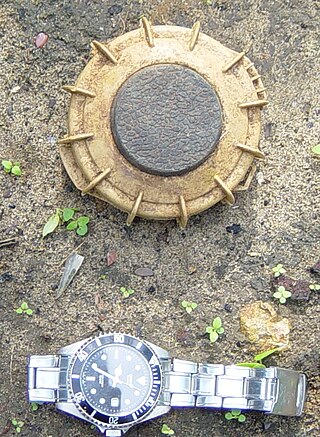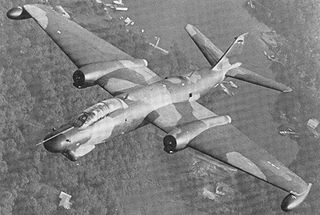The GATOR mine system is a United States military system of air-dropped anti-tank and anti-personnel mines developed in the 1980s to be compatible with existing cluster dispensers. It is used with two dispenser systems—the Navy 230 kg (500 lb) CBU-78/B and the Air Force 450 kg (1,000 lb) CBU-89/B. Additionally the mines are used with the land- and helicopter-based Volcano mine system.
An explosive booster is a sensitive explosive charge that acts as a bridge between a conventional detonator and a low-sensitivity explosive such as TNT. By itself, the initiating detonator would not deliver sufficient energy to set off the low-sensitivity charge. However, it detonates the primary charge, which then delivers an explosive shockwave that is sufficient to detonate the secondary, main, high-energy charge.

The CBU-97 Sensor Fuzed Weapon is a United States Air Force 1,000-pound (450 kg)-class freefall Cluster Bomb Unit. It was developed and produced by Textron Defense Systems. A CBU-97 used in conjunction with the Wind Corrected Munitions Dispenser guidance tail kit is converted to a precision-guided weapon, and the combination is designated CBU-105.

The Mk 20 Rockeye II, CBU-99 Rockeye II, and CBU-100 Rockeye II comprise an American cluster bomb family which are employed primarily in an anti-tank mode against armored vehicles.

The JP233, originally known as the Low-Altitude Airfield Attack System (LAAAS), is a British submunition delivery system. It consists of large dispenser pods carrying several hundred submunitions designed to attack runways.

The CBU-24 is an unguided, aircraft delivered anti-personnel and anti-materiel weapon developed by the United States. Because it is an unguided weapon, the CBU-24 can be carried and dropped by any aircraft capable of carrying standard "dumb" or "iron" bombs.
The AGM-124 Wasp is a missile developed by the United States. The Wasp grew out of the 1975 WAAM program initiated by the US Air Force in order to develop a series of new air-to-ground anti-armour weapons for close-support aircraft. The three-pronged program led to the CBU-92/B ERAM, the CBU-90/B ACM, and the Wasp anti-armour missile. The Wasp is regarded as the most advanced of these weapons.

BLU-3 Pineapple was a cluster bomblet, 360 were deployed from the CBU-2A cluster bomb. It was used extensively in the Vietnam War by American forces. It was named "Pineapple" because of its appearance. On some Arc Light missions, the B-52Ds carried two SUU-24 dispensers in the bomb bay, containing a total of 10,656 bomblets.

PFM-1 is a scatterable high explosive anti-personnel land mine of Soviet and Russian production. It is also known as a Green Parrot or Butterfly Mine. The mines can be deployed from mortars, helicopters and aeroplanes in large numbers; they glide to the ground without exploding and will explode later upon contact.
Gravel mines, also called button mines, are small American-made air-dropped anti-personnel mines. They were used extensively during the Vietnam War as part of the McNamara Line. They were also used as a rapid-deployment area denial expedient, to provide a barrier during combat search and rescue (CSAR) operations between downed pilots or other endangered units and infantry threats.

An anti-personnel mine or anti-personnel landmine (APL) is a form of mine designed for use against humans, as opposed to an anti-tank mine, which target vehicles. APLs are classified into: blast mines and fragmentation mines; the latter may or may not be a bounding mine.
The CBU-87 Combined Effects Munition (CEM) is a cluster bomb used by the United States Air Force, developed by Aerojet General/Honeywell and introduced in 1986 to replace the earlier cluster bombs used in the Vietnam War. CBU stands for Cluster Bomb Unit. When the CBU-87 is used in conjunction with the Wind Corrected Munitions Dispenser guidance tail kit, it becomes much more accurate, and is designated CBU-103.
The BLU-108 is an air-delivered submunition, containing four further smart "Skeet" warheads. The system is manufactured by Textron Systems Weapon & Sensor Systems since 1992. The BLU-108 is released from a munitions dispenser, with a parachute being used to slow its descent. It then fires the four rapidly rotating skeets, which use multi-mode optical sensors to identify a variety of targets ranging from tanks and missile launchers to railway locomotives and stationary aircraft. When the skeet passes over what it considers a high priority target, it fires a 0.9 kg explosively formed penetrator providing armor-piercing and incendiary effects, as well as a fragmentation ring meant to damage any soft targets, primarily enemy personnel, in the immediate vicinity of the target.

The BLU-97/B Combined Effects Bomb is the submunition used in several cluster bomb type weapon systems, mainly the CBU-87 and its precision-guided version CBU-103. When the bomblets fall, they separate from the main bomb and independently free fall to the ground. They contain an inflatable bag (ballute) on the top of them, which slows them down and spreads them out. Once the bomblets reach a force of 6 Gs they arm themselves. As the bomblets fall, they are also spinning. Arming takes about 2.6 seconds. They have a combined shaped charge, fragmentation and incendiary effect on the target. It is very effective against and mainly used for anti-personnel, anti-materiel, and anti-armor.
The CBU-55 was a cluster bomb fuel–air explosive that was developed during the Vietnam War by the United States Air Force, and was used only infrequently in that conflict. Unlike most incendiaries, which contained napalm or phosphorus, the 750-pound (340 kg) CBU-55 was fueled primarily by propane. Described as "the most powerful non-nuclear weapon in the U.S. arsenal," the device was one of the more powerful conventional weapons designed for warfare.

Operation Shed Light was a crash development project in aerial warfare, initiated in 1966 by the United States Air Force to increase the ability to accurately strike at night or in adverse weather. During the 1960s the United States military worked hard to interdict the movement of men and materiel along the Ho Chi Minh trail. The North Vietnamese were experts in the use of weather and darkness to conceal their movement, and understanding the superiority of American air power put their skills immediately to good use. US forces seeking to impede the steady flow of supplies attempted to locate largely static targets during the day with poor results.
The CBU-98/B was a planned 385 kg (850 lb) anti-airfield cluster bomb, which consisted of 8 BLU-106/B BKEP projectiles and 24 British HB876 mines in an SUU-64/B Tactical Munitions Dispenser (TMD). The BLU-106/B was cancelled, and thus the CBU-98/B, was never produced.
The CBU-72 was a 550-pound (250 kg) American fuel-air cluster bomb used by the United States Military until 1996. It was very effective against armored vehicles, aircraft parked in the open, bunkers, and minefields.

Project High Wire was a United States Air Force (USAF) modernization programme for selected North American Aviation F-100C, D and F Super Sabres that were still in active inventory. It consisted of two detailed modification groups: significant electrical rewiring upgrade, and heavy aircraft maintenance and IRAN upgrade. These upgrades began in 1962.
The BLU-14/B was an American 347 kg (766 lb) ground-penetrating anti-vehicle mine for release by low-flying aircraft. It was a derivative of the MLU-10/B 750 lb (340 kg) land mine, and therefore essentially identical in shape and weight to the BLU-31/B anti-vehicle demolition mine and bomb. The designation "BLU" stands for Bomb Live Unit, as opposed to "BDU" used for practice.











